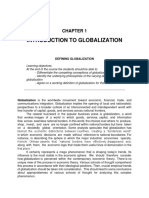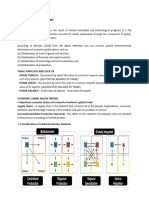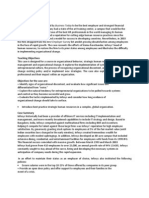0 ratings0% found this document useful (0 votes)
23 viewsTurkish Economy: Prof. DR Sencer Ecer Week 3
Turkish Economy: Prof. DR Sencer Ecer Week 3
Uploaded by
yaseminThe document discusses principles of the Ottoman economic worldview prior to the 19th century, including provisionism, traditionism, and fiscalism. Provisionism aimed to address market failures and provide competitive amounts of goods to meet needs. Traditionism emphasized maintaining the status quo and controlling change. Fiscalism focused on maximizing state revenues while minimizing expenditures. The Ottoman economy operated under a pragmatic system that balanced these principles at different administrative levels to provide for economic and social stability.
Copyright:
© All Rights Reserved
Available Formats
Download as PPTX, PDF, TXT or read online from Scribd
Turkish Economy: Prof. DR Sencer Ecer Week 3
Turkish Economy: Prof. DR Sencer Ecer Week 3
Uploaded by
yasemin0 ratings0% found this document useful (0 votes)
23 views14 pagesThe document discusses principles of the Ottoman economic worldview prior to the 19th century, including provisionism, traditionism, and fiscalism. Provisionism aimed to address market failures and provide competitive amounts of goods to meet needs. Traditionism emphasized maintaining the status quo and controlling change. Fiscalism focused on maximizing state revenues while minimizing expenditures. The Ottoman economy operated under a pragmatic system that balanced these principles at different administrative levels to provide for economic and social stability.
Original Title
3_Week_ECN401E_Turkish Economy
Copyright
© © All Rights Reserved
Available Formats
PPTX, PDF, TXT or read online from Scribd
Share this document
Did you find this document useful?
Is this content inappropriate?
The document discusses principles of the Ottoman economic worldview prior to the 19th century, including provisionism, traditionism, and fiscalism. Provisionism aimed to address market failures and provide competitive amounts of goods to meet needs. Traditionism emphasized maintaining the status quo and controlling change. Fiscalism focused on maximizing state revenues while minimizing expenditures. The Ottoman economy operated under a pragmatic system that balanced these principles at different administrative levels to provide for economic and social stability.
Copyright:
© All Rights Reserved
Available Formats
Download as PPTX, PDF, TXT or read online from Scribd
Download as pptx, pdf, or txt
0 ratings0% found this document useful (0 votes)
23 views14 pagesTurkish Economy: Prof. DR Sencer Ecer Week 3
Turkish Economy: Prof. DR Sencer Ecer Week 3
Uploaded by
yaseminThe document discusses principles of the Ottoman economic worldview prior to the 19th century, including provisionism, traditionism, and fiscalism. Provisionism aimed to address market failures and provide competitive amounts of goods to meet needs. Traditionism emphasized maintaining the status quo and controlling change. Fiscalism focused on maximizing state revenues while minimizing expenditures. The Ottoman economy operated under a pragmatic system that balanced these principles at different administrative levels to provide for economic and social stability.
Copyright:
© All Rights Reserved
Available Formats
Download as PPTX, PDF, TXT or read online from Scribd
Download as pptx, pdf, or txt
You are on page 1of 14
Turkish Economy
Prof. Dr Sencer Ecer
Week 3
Ottoman History Writing and Changing
Attitudes Towards the Notion of “Decline”
• Quataert (2003): «Europeans were underselling in Middle Eastern markets not
because of their manufacturing efficiency but because they were dumping goods.
Supported by the profits of the Atlantic economy, they sent cloth as ballast to
Ottoman ports and sold it below their own costs, using New World gold to buy
desired commodities for profitable resale back in Europe. Subsequently,
researchers questioned the decline of Ottoman manufacturing. They agreed with
Issawi that big factories were largely absent and they conceded that certain
handicraft industries exporting goods to Europe had faded away. They further
concurred that Ottoman imports of European manufactures had increased
impressively in the post-1750 era. But they disagreed about the conclusions to be
drawn from such observations and set about investigating the actual fate of the
Ottoman manufacturing sector. Ottoman manufacturing, it turns out, had not
declined.»
Ottoman Economic World View before the
19th century (Genc, 2003)
• Pragmatic, prolific
• Just like in other traditional societies, state goals cannot be classified
as «purely» economic
• However, there are some principles
• «The impact of the state on the economy is limited anyway»
Principles of Ottoman Economic Worldview:
Provisionism
• Address market failures and try to provide the competitive amount
• Low productivity
• Problems with state interference, unintended consequences
• Expensiveness of transportation
• Provisionism applies to all levels in the production chain
Provisionism
• Agriculture:
• Family enterprises with 60-150K m2 land
• Land owned by the state
• Not allowed: Division with inheritance, migration, keeping the land idle, allocation as a foundation
(vaqf)
• States control mostly applies to populations between 3-20K (kaza)
• Prodcution is kept in this area (diameter about 50km)
• Purchasers of agricultural product were organized as purchasing groups
(Lonca) which were regulated to stay at an average size
• Remaining products were allocated to the army and the palace and to
traders for Istanbul, then to traders for elsewhere in the empire (in exchange
for internal tariff). Exports are allowed only after all these.
Provisionism
• Exports were carefully regulated,
• what and how much to export
• High tariffs
• Imports were allowed, unregulated
• Capitulations emerged from out of this policy
Principles of Ottoman Economic Worldview:
Traditionism
• «no change» or «controlled change»
• Scarcity
• Any fluctuation, imbalance could turn into serious famine because of lack of
transportation
• Consumption controls: Somptary laws (men-i israfat) against luxury
goods
• Strict allocation of capital and labor to sectors
• Shifts were not welcome because they would be at the expense of other
sectors
• Tradesmen associations’ employee and store numbers were fixed
Traditionism
• Shariah law was the main source and reference as well as laws issued
by the sultan, local traditions and customs
• A principle: «not to be against the ancient»
• Ancient (kadim) was defined as «no one remembers what was before»
• Change as a process led to the third principle
Mechanisms of social change which can be found
in the literature (based on Wilterdink 2014)
• Mechanisms of social change which can be found in the literature (based on Wilterdink 2014)
• Learning: Evolutionary theories (Dosi, 1982; Nelson & Winter, 1982) in social sciences stress the cumulative nature
of human knowledge. Actors realize mistakes, apply new ideas and engage in processes of learning, which results in
tacit and codified new knowledge (Cowan, David, & Foray, 2000).
• Variation: Variation can range from 1) new (collective) ideas to 2) single innovation projects which introduce
novelty and hence variation. Ad 1) Collective ideas are the cause and consequence of social change. The spread of
beliefs, values, value systems, of fashions, of religions, of cultural symbols, of rules of behavior. Ad 2) Single
innovation projects are on the one hand incremental innovation projects that innovate along a given trajectory; on
the other hand, radical innovations that deviate from the trajectory and may lay the ground for a new trajectory.
• Selection: This incorporates processes of adoption, diffusion and imitation, but also processes of decline and death
of initiatives.
• Conflict: Group conflict has often been viewed as a basic mechanism for social change, these include revolutions,
but also minor conflicts. Social change in this view, is the result of the struggle between a predominant class and a
dominated class which strives for (radical) change. (conflict model of society by Ralf Dahrendorf)
• Competition: seen as a powerful mechanism of change as competition makes it more likely to introduce
innovations in order to have competitive advantages.
Mechanisms of social change which can be found
in the literature (based on Wilterdink 2014)
• Mechanisms of social change which can be found in the literature (based on Wilterdink 2014)
• Cooperation: Although competition as a driver dominates theories that put individualism, individual utility at the
fore, where social change is the results of individuals pursuing their self-interest, other strands of literature have
shown that cooperation (e.g. literature on innovation systems, game theory) or altruism (e.g. Ernst Fehr) also lay
the basis for human action.
• Tension and adaptation: In structural functionalism social change is seen as an adaption to some tension in the
social system. E.g. a gap between fast-changing technology and necessary associated institutional change of some
type (see W. Fielding Ogburn)
• Diffusion of (technological) innovations: Some social changes results from innovations adopted in society, may be
technological invention, scientific knowledge, but also new beliefs, ideas, values, religions, in short ideas. High
uncertainty, most innovations disappear, those that survive follow an S-curve of adoption (cf. Geroski, 2000).
• Planning and institutionalisation of change: Social change may result from goal-directed large scale planning, by
governments, bureaucracies, and other large scale organisations. The wider the scope, the more the competencies
needed, the more difficult to reach goals and the more likely that unforeseen events interfere. Planning implies
institutionalisation of change, but institutionalisation does not imply planning (Wilterdink, 2014). Included here are
changes in the organisation of the state, interstate relations, laws and directives, programmes etc.
Fiscalism
• Max revenues, min expenditures
• Telecom regulations today
• Always remind that tax revenues will not decline
• Health Economics
• Cost minimization
• Same in different countries
• Croatia, Romania, Bulgaria
• Some changes in recent tax reforms
Fiscalism
• Objective reasons for fiscalism
• Low productivity
• Costly transportation
• Low quantities of marketed products
• Only this factor can be altered by the state
• Subjective reasons
• Planned allocations did not lead to a deepening of the market
• Deepening of market could lead to a class stratification, rival families could
emerge
• Price controls: normal profit margin 5-15%
• Interest: 15-25% observed in military class consumption and administration financing
Conclusions (Genc, 2003)
• The Ottoman economic outcomes typically reflect a combination of
the three principles at different levels
You might also like
- Additive Manufacturing Seminar PresentationDocument19 pagesAdditive Manufacturing Seminar PresentationMohammed Tanveer55% (11)
- FintechDocument53 pagesFintechDatta Datta100% (1)
- Globalization of Economics and Development Globalizationof Economics and DevelopmentDocument63 pagesGlobalization of Economics and Development Globalizationof Economics and DevelopmentNipul Bafna100% (1)
- Unit 1 The Capitalist Revolution 1.0Document33 pagesUnit 1 The Capitalist Revolution 1.0knowme73No ratings yet
- Five Theories of EntrepreneurshipDocument10 pagesFive Theories of EntrepreneurshipAina Olukayode Emmanuel75% (4)
- Nintendo Strategy CaseDocument7 pagesNintendo Strategy CaseRohit Oberoi50% (2)
- Macro OB Case QuestionsDocument4 pagesMacro OB Case Questionsrock sinhaNo ratings yet
- Unit 1 The Capitalist Revolution 1.02Document48 pagesUnit 1 The Capitalist Revolution 1.02m.summer.brockNo ratings yet
- Understanding RitzerDocument168 pagesUnderstanding RitzerShalyn IbnosaliNo ratings yet
- The Contemporary World Chapter 1 and 2Document12 pagesThe Contemporary World Chapter 1 and 2Aj PajimulaNo ratings yet
- Contemp World Modules 1 4Document34 pagesContemp World Modules 1 4FAJUNIO, FRENCIE MAE A.No ratings yet
- 1 Introduction GrowthDocument30 pages1 Introduction Growthaleema anjumNo ratings yet
- Theories of Dev 2021Document101 pagesTheories of Dev 2021LAURENT JIBUNGENo ratings yet
- AdeelQureshi - 1701 - 18669 - 2 - L11 Philosophy of EconomicsDocument26 pagesAdeelQureshi - 1701 - 18669 - 2 - L11 Philosophy of EconomicsAmmad AktharNo ratings yet
- GE104 - MODULE 1.1 - GlobalizationDocument47 pagesGE104 - MODULE 1.1 - GlobalizationKimberly Joyce Olivia Navarro100% (1)
- Week 09 Globalization and WorkDocument19 pagesWeek 09 Globalization and Workyz9684No ratings yet
- 2 Theories of Migration 2023 10 16 16 50 38Document37 pages2 Theories of Migration 2023 10 16 16 50 38Yasin AbduNo ratings yet
- Chapter One: Globalisation: by Anothony GiddensDocument16 pagesChapter One: Globalisation: by Anothony GiddensmostafahhhNo ratings yet
- Globalization of Economics and Development Globalizationof Economics and DevelopmentDocument63 pagesGlobalization of Economics and Development Globalizationof Economics and DevelopmentUli UlyNo ratings yet
- Globalization PDFDocument61 pagesGlobalization PDFNixon PeraltaNo ratings yet
- MODULE 2 Globalization 11Document42 pagesMODULE 2 Globalization 11Gerald MagaitaNo ratings yet
- GlobalizationDocument60 pagesGlobalizationFrancesca Veronique TablonNo ratings yet
- Contemporary World NotesDocument13 pagesContemporary World NotesLalaine LuzaNo ratings yet
- Lecture4 - 5 - 6trade EnvironmentDocument50 pagesLecture4 - 5 - 6trade EnvironmentJac CreationsNo ratings yet
- Introduction To MacroeconomicsDocument29 pagesIntroduction To MacroeconomicsIska CoteloNo ratings yet
- Contemporary World Prelim ReviewerDocument15 pagesContemporary World Prelim ReviewerLJ RamirezNo ratings yet
- Chap 1 - How Do We Compare Economies?Document57 pagesChap 1 - How Do We Compare Economies?vavisoizicNo ratings yet
- Globalisation IntroductionDocument32 pagesGlobalisation IntroductionSadhika GuptaNo ratings yet
- Module 1.5 Structures of GlobalizationDocument15 pagesModule 1.5 Structures of GlobalizationJade BoadoNo ratings yet
- GECC 104 Module 5 Ethics PDFDocument14 pagesGECC 104 Module 5 Ethics PDFNi Ki TaNo ratings yet
- International BusinessDocument27 pagesInternational Businessgn.linhbtfNo ratings yet
- Group 2 Global Economy Market IntegrationDocument7 pagesGroup 2 Global Economy Market IntegrationdennissabalberinojrNo ratings yet
- Lesson 3 - Theories of DevelopmentDocument29 pagesLesson 3 - Theories of Developmentgayel.makipig.21No ratings yet
- Marxian TheoryDocument20 pagesMarxian TheoryChittesh SachdevaNo ratings yet
- Unit 1 - The Capitalist Revolution - 1.0Document34 pagesUnit 1 - The Capitalist Revolution - 1.0maria aghaNo ratings yet
- Introduction To Economics: PreliminariesDocument26 pagesIntroduction To Economics: PreliminariesTanayJohariNo ratings yet
- GE 1211 - Campbell Chapter 1 PPT NotesDocument29 pagesGE 1211 - Campbell Chapter 1 PPT NotesAlexa AmbrayNo ratings yet
- Module1 1Document29 pagesModule1 1olusanyadaniel01No ratings yet
- Globalization, Modernization, and EuropeanizationDocument11 pagesGlobalization, Modernization, and EuropeanizationAbdul Qadeer KhanNo ratings yet
- TCD Reviewer 1-5Document12 pagesTCD Reviewer 1-5iyNo ratings yet
- The Classical TheoryDocument16 pagesThe Classical Theorysocial sitesNo ratings yet
- The Global EconomyDocument3 pagesThe Global EconomyRainier DreuNo ratings yet
- BSM940 Lecture2 Institutions and DevelopmentDocument20 pagesBSM940 Lecture2 Institutions and DevelopmentNishant ShahNo ratings yet
- Major Development Theories - Tadele FaysoDocument20 pagesMajor Development Theories - Tadele FaysotadeleNo ratings yet
- The Modern World-System As Capitalist World-EconomyDocument14 pagesThe Modern World-System As Capitalist World-EconomyRonella DozaNo ratings yet
- Seminar On The Politics of Globalization and InternationalDocument82 pagesSeminar On The Politics of Globalization and InternationalEtanaNo ratings yet
- IPE SLAYTLAR SON HALİ-birleştirildiDocument144 pagesIPE SLAYTLAR SON HALİ-birleştirildiperisuyildirim.atNo ratings yet
- Chapter OneDocument29 pagesChapter OneZack AlasowNo ratings yet
- GeopoliticsDocument125 pagesGeopoliticsRishabh TiwariNo ratings yet
- EH409 CultureDocument43 pagesEH409 CultureMelanie XNo ratings yet
- Trade, Interdependence, and Globalization: by Dr. Marium Minhas BandealiDocument61 pagesTrade, Interdependence, and Globalization: by Dr. Marium Minhas Bandealifatima aghaNo ratings yet
- TCW Midterms Notes and LEDocument17 pagesTCW Midterms Notes and LEAngel HannahNo ratings yet
- DV Citations-2Document9 pagesDV Citations-2tessa.giannoneNo ratings yet
- CH 3 Global - TDocument28 pagesCH 3 Global - TdebisahirpaNo ratings yet
- Comtemporary World LectureDocument10 pagesComtemporary World LectureJed Nicole AngonNo ratings yet
- NOTES Contemporary Economic History2Document47 pagesNOTES Contemporary Economic History2Alexandra MoldovanNo ratings yet
- Kitsing Ibpp Slides Voc Eu GRE 131123Document58 pagesKitsing Ibpp Slides Voc Eu GRE 131123mayank AgrawalNo ratings yet
- BAUP1112 Islamic Perspective in Relation To Town PlanningDocument46 pagesBAUP1112 Islamic Perspective in Relation To Town PlanningAlya syaahindahNo ratings yet
- Capitalism and DemocracyDocument22 pagesCapitalism and Democracyaknaeem246No ratings yet
- Jeremy Bentham & John Stuart MillDocument14 pagesJeremy Bentham & John Stuart Millsteven jobsNo ratings yet
- 5 Waves of TechnologyDocument50 pages5 Waves of TechnologyNelzen GarayNo ratings yet
- Chapter-1_PresentationDocument50 pagesChapter-1_PresentationAngelo BorceloNo ratings yet
- Notes OnDocument4 pagesNotes OnSadique GhaniNo ratings yet
- MB 0037 Internal Business ManagementDocument14 pagesMB 0037 Internal Business ManagementUlhas MahaleNo ratings yet
- Lesson 7: Signature Assignment Presentation Planning ToolDocument5 pagesLesson 7: Signature Assignment Presentation Planning Toolapi-540468837No ratings yet
- Business Strategy AS1Document23 pagesBusiness Strategy AS1ionvidrascu2013No ratings yet
- ERP Benchmark ReportDocument11 pagesERP Benchmark ReportamberNo ratings yet
- SAP Business One Is Now Localized in Romania and BulgariaDocument2 pagesSAP Business One Is Now Localized in Romania and Bulgariairinaoprea2No ratings yet
- Entrepreneurship and Entrepreneurial Ecosystems: Edward J. MaleckiDocument21 pagesEntrepreneurship and Entrepreneurial Ecosystems: Edward J. MaleckiRaza AliNo ratings yet
- CH 05Document16 pagesCH 05Aamir Akber AliNo ratings yet
- DR Dapiton & Engr Alma's Paper - Education in The 21st Cent AbstractDocument14 pagesDR Dapiton & Engr Alma's Paper - Education in The 21st Cent AbstractBruno SaturnNo ratings yet
- Eterprenuership 2Document9 pagesEterprenuership 2Abdela Aman MtechNo ratings yet
- MSMEs Project ReportDocument11 pagesMSMEs Project ReportAnkita GoyalNo ratings yet
- PLM BrochureDocument8 pagesPLM Brochureshubham shelkeNo ratings yet
- Stanford On-Demand Online Courses: Discover The Paths To PowerDocument4 pagesStanford On-Demand Online Courses: Discover The Paths To PowerJosephNo ratings yet
- Development Technology Rutqis Lebanna Rohanitra - 191214166Document5 pagesDevelopment Technology Rutqis Lebanna Rohanitra - 191214166Rutqis Lebanna RohanitraNo ratings yet
- Crossing The Chasm - SummaryDocument46 pagesCrossing The Chasm - SummaryRoffianto Adi NugrohoNo ratings yet
- Infosys Case StudyDocument4 pagesInfosys Case StudyJerold Savio75% (4)
- Fundamentals of Modern Marketing ThoughtDocument37 pagesFundamentals of Modern Marketing ThoughtEmmanuel SidaNo ratings yet
- CH2-AT3-G1-For-PrintDocument20 pagesCH2-AT3-G1-For-PrintnoprebettyNo ratings yet
- 07 Handout 1Document5 pages07 Handout 1Nigel NasisNo ratings yet
- Robotic Process Automation RpaDocument4 pagesRobotic Process Automation RpaJohn Torres100% (1)
- Digital Orientation - Conceptualization and Operationalization - Kindermann - 2021Document13 pagesDigital Orientation - Conceptualization and Operationalization - Kindermann - 2021Anthony NguyenNo ratings yet
- Maguene Moussavou Debate PresentationDocument13 pagesMaguene Moussavou Debate PresentationjNo ratings yet
- MonographDocument91 pagesMonographkarmveer singhNo ratings yet
- InnovationDocument76 pagesInnovationRista ChairaniNo ratings yet
- Bayer Innovation Council Sustainability Presentation2Document34 pagesBayer Innovation Council Sustainability Presentation2mackoypogiNo ratings yet
- Management Accountant July 2020Document124 pagesManagement Accountant July 2020ABC 123No ratings yet
- 4.australian Leadership SurveyDocument106 pages4.australian Leadership SurveyprasadkulkarnigitNo ratings yet

























































































